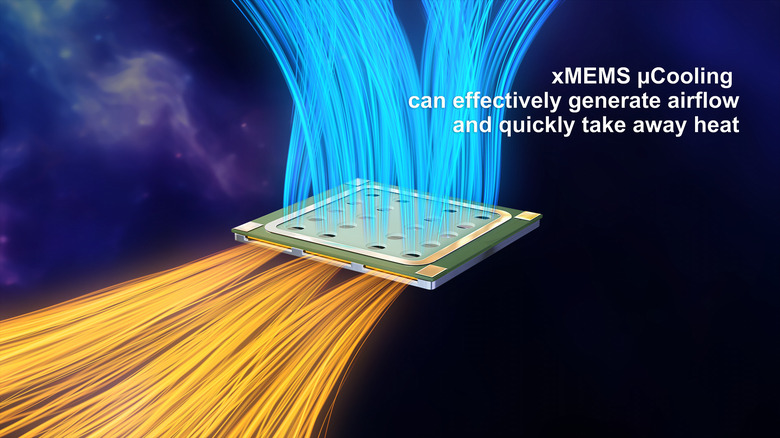
Homepixel/Getty Images
In the tech world, top-tier microprocessors constantly evolve to offer peak performance. Mobile and desktop chipmakers alike have been pushing performance limits and downsizing components more and more to accommodate more transistors on a single silicon chip, seeking a persistent power increase.
Advertisement
However, the real challenge lies in sustaining top-notch performance. This becomes even more pertinent with space limitations inside devices such as phones and laptops, which cannot house active cooling solutions sufficiently large enough to dissipate heat at the same rate as it is generated. To address these issues, a company named xMEMS Labs recently unveiled an active micro-cooling unit that is just one-millimeter thick.
This miniscule and unobtrusive gadget may have the potential to completely change how we use our gadgets, from phones to laptops, handheld gaming PCs, consoles, and more. The company has previously been known for the world’s first solid-state speakers. In these solid-state speakers, silicon structures move back and forth instead of orthodox diaphragms to generate sound.
Advertisement
Tiny Yet Powerful Active Cooling

xMEMS Labs
Downsizing of advanced semiconductors with the passage of time is a well-established phenomenon. At the same time, PC brands have been creating laptops with mobile chips to attain higher battery backup and effectively reduce the size of the devices. The interconnectedness of various components, such as on Apple’s system-on-a-chip layout for the M series Mac chips that include the CPU, GPU, RAM, and storage modules on a single in chip, results in faster communication between these components, and thus, better performance.
Advertisement
At the same time, the pursuit for more convenient designs results in design constraints that leave out cooling solutions from these new advanced machines. The XMC-2400 is proposed to tackle these constraints and potentially become a lifesaver for compact machines as workloads are bound to increase with on-device AI applications.
xMEMS Labs’ planned cooling system comes from a U.S.-based company specializing in piezoelectric solutions (which convert motion at microscopic level into electricity). The company is known for unconventional deployment of micro-electromechanical systems (MEMS) technology, which includes using electromechanical systems on a silicon substrate to integrate sensors and actuators with electronics and create miniature devices with moving parts ranging from 1 to 1,000 micrometers. While MEMS technology is not entirely new, its integration into consumer electronics is relatively recent, making it a novel innovation in this context.
Advertisement
XMC-2400: How does it work

xMEMS Labs
The company’s newly launched cooling solution, called XMC-2400, employs piezoelectric actuation to create airflow in a fashion similar to the solid-state speakers mentioned above. Unlike traditional cooling systems that use mechanical fans or passive heat dissipation, the «Fan on a Chip» technology harnesses the properties of reverse-piezoelectric materials and generates mechanical motion when subjected to an electric field. This leads to a microscopic layer moving in a linear fashion. This motion generates air pressure inside the chamber of the chip, which after reaching a threshold, gets released by a valve and airflow is created.
Advertisement
The cooling system is designed to generate sufficient airflow within a tiny footprint. Despite its compact dimensions of 9.26 x 7.6 x 1.08 mm and weighing less than 0.15 grams, the cooling solution can provide two-way airflow at up to 39 cm3/s (cubic centimeter per second) with 1,000 pascals of back pressure (one-thousandth of atmospheric pressure) per instance.
It is claimed to be 96% smaller and lighter than active-cooling alternatives not based on silicon. The system has an estimated 30 milliwatt power consumption and operates at ultrasonic frequencies, which makes it far less noisy (almost silent) compared to other active cooling units. The all-silicon solution also boasts of reliability, high uniformity, and durability with IP58 water resistance. It should be particularly valuable in regions experiencing hot summers.
Advertisement
Comparison with other advanced solutions

xMEMS Labs
The XMC-2400 is not the first innovation in active fanless mobile cooling. Previously, technologies such as vibrating fans or active heat pipes have been introduced to address the heat generated by powerful processors inside mobile devices.
Advertisement
Vibrating fans create noise and are undesirable for sensitive devices, while active heat pipes take up a lot of space and get degraded over time, losing efficiency. Similarly, other solutions have limitations, but XMC-2400’s piezoelectric-based design looks very close to offering an ideal solution.
Frore Systems, another U.S.-based company, is a pioneer in the MEMS-based chip cooling space. It has been trying to get a similar technology called AirJet Mini into laptops since 2022. However, the AirJet Mini is at least 2.5 times as thick as the XMC-2400 and lacks robust IP certification.
In contrast, xMEMS Labs claims that its XMC-2400 is about 15 times more efficient when comparing airflow generation per volume of enclosed spaces. These factors explain why AirJet Mini saw such little success. While Frore has focused on PCs and Laptops, xMEMS Labs sets its sights on mobile devices, especially smartphones. The company has also tasted success with other innovative products, such as its micro speakers, with over half a million units shipped in the first six months of 2024. It is anticipated that XMC-2400 will also bring about advancements that are difficult to envision today.
Advertisement
Applications for the future

xMEMS Labs
The introduction of the XMC-2400 aligns with broader trends in the development of piezoelectric technologies. Piezoelectric materials are being increasingly explored for their cooling capabilities, offering a novel approach to thermal management that traditional systems cannot match. Some research also suggests using a mix of piezoelectric solutions with other solutions to obtain the best of both worlds. The piezoelectric materials are not only efficient but also scalable, making them suitable for a wide range of applications, from consumer electronics to industrial equipment.
Advertisement
The company projects XMC-2400 to be available in a 2×4 array of cells, where multiple units can be stacked for scalability. Its cell architecture enables the number of cells to be scaled up or down to fit the desired application. In addition to this, the XMC-2400 will be available in top-venting and side-venting variations for versatile integration in different form factors.
xMEMS Labs already has TSMC as a fabrication vendor, while Bosch is another source. The cooling system is slated to be showcased to prime customers and partners in September 2024 at events in Shenzhen and Taipei. Subsequently, the company plans to provide samples to customers starting the first quarter of 2025.